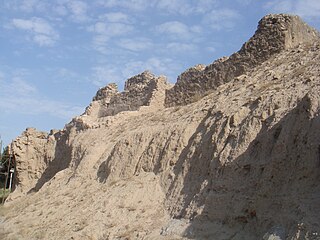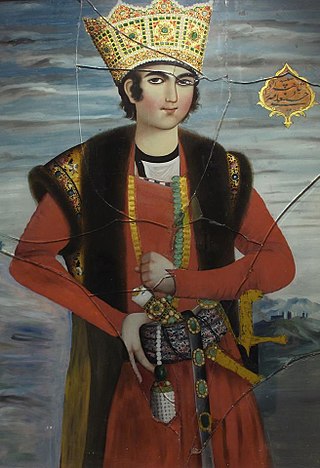
Shahr-e Ray or simply Ray is the capital of Ray County in Tehran Province, Iran. Formerly a distinct city, it has now been absorbed into the metropolitan area of Greater Tehran as the 20th district of municipal Tehran, the capital city of the country.

Fath-Ali Shah Qajar was the second Shah (king) of Qajar Iran. He reigned from 17 June 1797 until his death on 24 October 1834. His reign saw the irrevocable ceding of Iran's northern territories in the Caucasus, comprising what is nowadays Georgia, Dagestan, Azerbaijan, and Armenia, to the Russian Empire following the Russo-Persian Wars of 1804–1813 and 1826–1828 and the resulting treaties of Gulistan and Turkmenchay. Historian Joseph M. Upton says that he "is famous among Iranians for three things: his exceptionally long beard, his wasp-like waist, and his progeny."

The Shāh Abdol-Azīm Shrine, also known as Shabdolazim, located in Rey, Iran, contains the tomb of ‘Abdul ‘Adhīm ibn ‘Abdillāh al-Hasanī. Shah Abdol Azim was a fifth generation descendant of Hasan ibn ‘Alī and a companion of Muhammad al-Taqī. He was entombed here after his death in the 9th century.

The Karabakh Khanate was a semi-independent Turkic Caucasian khanate on the territories of modern-day Armenia and Azerbaijan established in about 1748 under Iranian suzerainty in Karabakh and adjacent areas.

Behshahr is a city in Mazandaran, Iran & the capital of Behshahr County. Located on the coast of the Caspian Sea, at the foot of the Alborz, it is approximately 40 kilometres (25 mi) from Sari. At the 2006 census, its population was 83,537, in 22,034 families.

Damghan is the capital of Damghan County, Semnan Province, Iran. At the 2006 census, its population was 57,331, in 15,849 families. It is situated 342 km (213 mi) east of Tehran on the high-road to Mashad, at an elevation of 1,250 m (4,101 ft). It is one of the oldest cities on the Iranian plateau, stretching back 7,000 years, and boasts many sites of historic interest. The oldest of these is Tappeh Hessar, lying to the southeast of the city, which holds the ruins of a castle dating from the Sasanian Empire.

Tang-e Vashi is a gorge and mountain pass in the Alborz range of Iran (Persia). It is a popular tourist attraction in Tehran Province.
Shahan Dasht, locally known as Shoon Dasht, is a village in Bala Larijan Rural District, Larijan District, Amol County, Mazandaran Province, Iran.

Damghan County is in Semnan province, Iran. The capital of the county is the city of Damghan. At the 2006 census, the county's population was 81,993 in 23,020 households. The following census in 2011 counted 86,908 people in 25,554 households. At the 2016 census, the county's population was 94,190 in 30,296 households.

The Shah Diamond was found at the Golconda mines in what is now Andhra Pradesh, South India, probably in 1450, and it is currently held in the Diamond Fund collection of Moscow's Kremlin Armoury.

Cheshmeh-Ali is an ancient recreational place, located in the south of Tehran and north of Rey in the country of Iran. The spring is spot in the neighborhood of Ebn-e Babooyeh, Tughrul Tower, and below the Rashkan castle and next to Rey Castle and Fath Ali shah inscription. In the past, carpet sellers and people used to wash their carpets there, with their idea that the property of this spring water is good and clean for carpets and make them full lighter color by its mineral water.

Rashkan Castle was a castle in Tehran Province in northern Iran. It was located near Cheshmeh Ali, Shah-Abdol-Azim shrine and Fath Ali shah inscription (Cheshmeh-Ali). The castle was intended to hold Rey, Iran. Rashkan castle was erected with plaster of lime and ashes or sand with stones. It was built during the Parthian rule of Persia.
Cheshmeh Ali is a village in Neyzar Rural District, Salafchegan District, Qom County, Qom Province, Iran. At the 2006 census, its population was 203, in 59 families.

Mohammad Taqi Mirza Hessam os-Saltaneh was a Persian Prince of the Qajar dynasty, son of Fath Ali Shah. He was Governor-General (beglerbegi) of Kermanshah and of Boroujerd.

Rey Castle was an ancient castle or defensive wall, located in Cheshmeh-Ali, south of Tehran and north of Rey. The castle is located above the Fath Ali shah inscription and dates back to 4000 BC in the Medes empire. It is assumed that the Castle was ruined by an earthquake and that Seleucus I Nicator rebuilt it.

The Amir Chakhmaq Mosque, also known as Dahouk mosque, is a historical mosque from the Timurid era in Yazd, in Iran. It was built on orders of Jalal ed-Din Amir Chakhmaq Shami, who was the governor of Yazd and a general of Shahrukh Mirza. The mosque was completed in 1438. From the viewpoint of aesthetics, dimension and importance, it is one of the most outstanding buildings in Yazd.

Abdollah Mirza Qajar was an Iranian prince (shahzadeh) of the Qajar dynasty, the 11th son of Fath-Ali Shah, king of Qajar Iran from 1797 to 1834. Abdollah was the governor of Zanjan. He had two children, Mohsen Mirza and Shams al-Molok, with his wife. Other than that, he had 19 sons and 9 daughters from his concubines.

Hossein Ali Mirza, a son of Fath-Ali Shah, was the Governor of Fars and pretender to the throne of Qajar Iran.

















